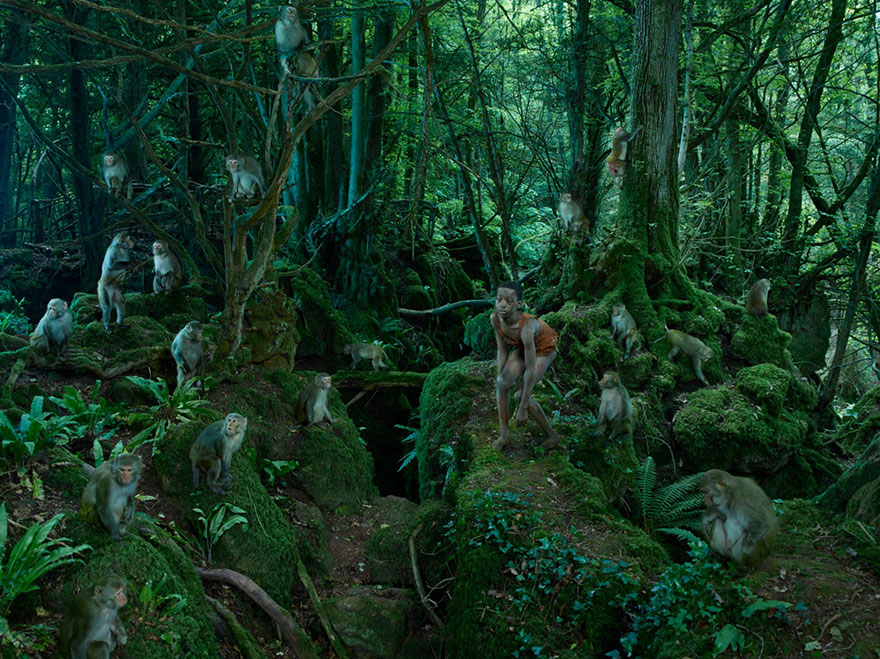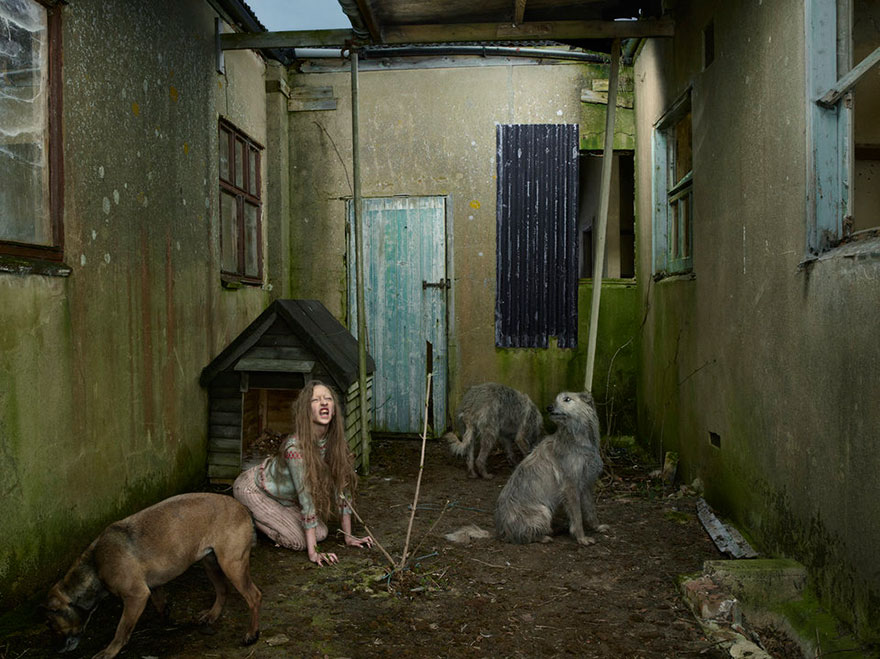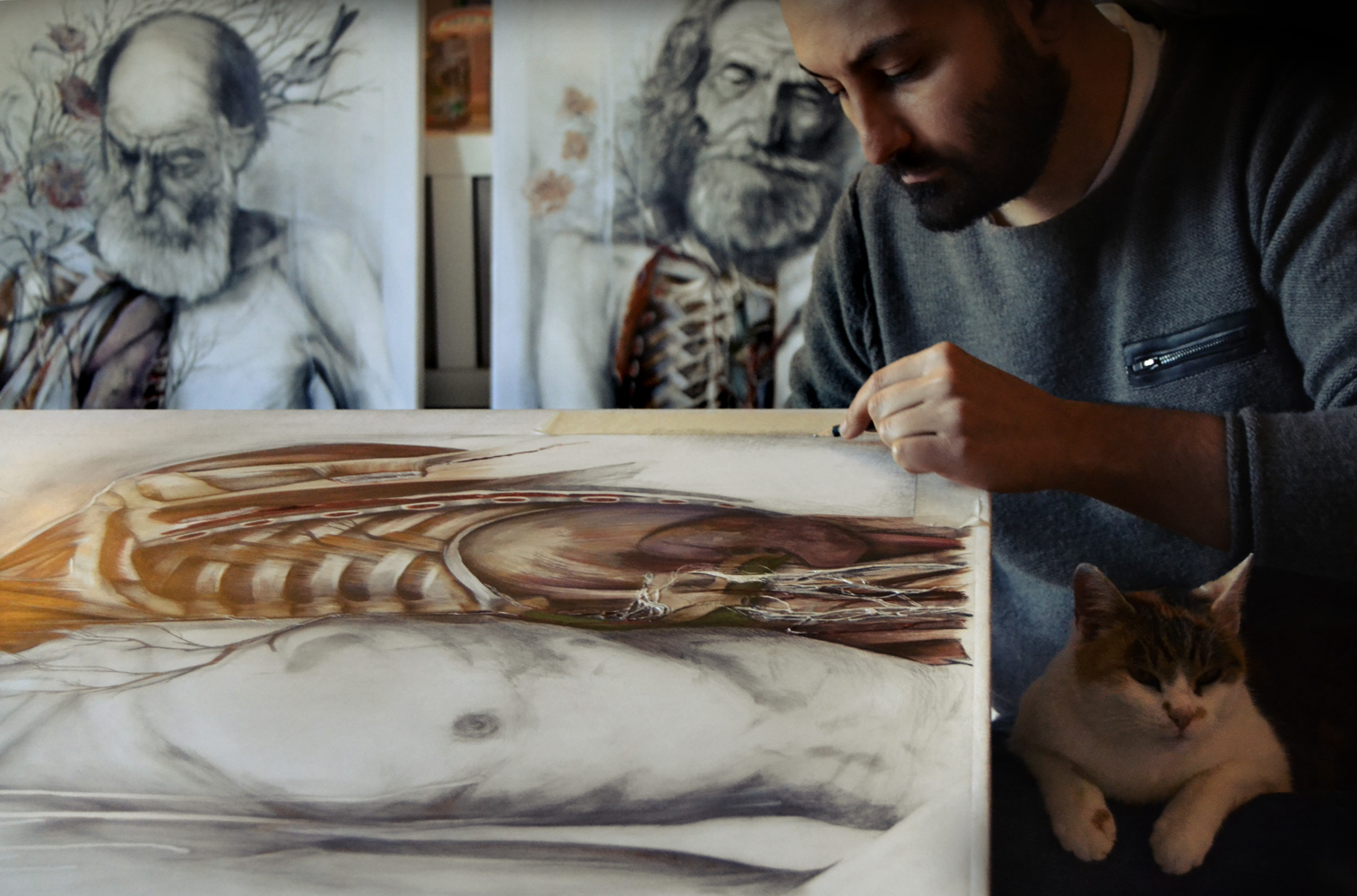
Last month, Disney released the trailer for their upcoming remake of the favored childhood tale, The Jungle Book. Unlike the 1967 cartoon, this iteration appears to take a much darker, adult approach to the tale of a young boy raised in the wild by animals.
Though the premise of Jungle Book may seem far-fetched, there are actually a surprising amount of documented examples of feral children throughout the last century. London-based photographer Julia Fullerton-Batten recently completed Feral Children; a project where she recreates the tangible histories of abused, abandoned, and forgotten children.
She first became inspired when she read The Girl with No Name, an incredible true story of 5-year old Marina Chapman, who was kidnapped and left alone in a Columbian jungle. For five years Marina coexisted with a family of capuchin monkeys until she was eventually discovered by hunters. The book goes into great detail of how Marina was cared for by the animals, prompting Fullerton-Batten, a mother of two, to do more research.
She spent months combing through history books and eventually found over 15 accounts from 5 continents of children that had been reared by animals with little or no human contact. The circumstances ranged from infants being snatched by wild animals to children grossly neglected by parents. In every situation, the child physically and mentally evolved to their surroundings, frequently assuming a four-legged position and losing the ability of human speech.
Fullerton-Batten sought to recreate the scenes with as much attention to detail as possible and enlisted the help of BBC broadcaster and anthropologist, Mary-Ann Ochota.
“The most trying time was researching the project and finding out how many cases there were. I often reflected that these were cases that were public knowledge; of course we don’t know how many other unknown cases there could have been,” She said in an interview with fEATURE SHOOT.
An incredible amount of time was put into casting the children and scouting the locations, as well as photographing the actual live animals. She further explains “As nude photographs would have been somewhat salacious, my stylist sourced old, discarded clothing that had to be again pre-treated to look authentic. Similar extreme efforts were required for their hair and make-up to simulate the child’s exposure to the wilderness.”
Each story has it’s own intriguing details and a wide range of endings from healthy rehabilitation to mysterious death.
John Ssebunya (The Monkey Boy), Uganda, 1991
John ran away from home in 1988 when he was three years old after seeing his father murder his mother. He fled into the jungle where he lived with monkeys until 1991. When was captured and cleaned up, it was found that his entire body was covered in hair and had calluses on his knees from walking like a monkey. Despite physical ailments, John learned to speak and even become a well known singer with the Pearl of Africa children’s choir.
Oxana Malaya, Ukraine, 1991
Oxana was found when she was eight years old and had been living with dogs for the past six years. She sought comfort in a farm kennel when she was three after her alcoholic parents left her outside. When discovered, she ran on all fours, panted like a dog, bared her teeth and even barked. Intensive therapy has allowed her to learn social and verbal skills of a five year old and she now lives at a clinic in Odessa where she works with the hospital’s farm animals.
The Leopard Boy, India, 1912
The two year old boy was taken by a leopardess from his home in India in 1912. Three years later he was found when a hunter killed the leopard and discovered the boy amongst her cubs. When he was returned to his village, his knees were covered with hard callouses, his toes were bent upright, and his palms, toe- and thumb-pads were covered with a tough, horny skin. He caught and ate raw fowl, fought with everyone who approached him, and could run on all fours as fast as an adult man could do upright. He eventually learned to walk and even learned to speak. He died young from cataracts – an illness not caused by his experiences in the jungle.
Sujit Kumar (Chicken Boy), Fiji, 1978
Sujit exhibited dysfunctional behavior as a child and his parents subsequently locked him in a chicken coop. When he was eight years old, he was found clucking and flapping in the middle of a road. He pecked at his food, crouched on a chair as if roosting, and would make rapid clicking noises with his tongue. His fingers were turned inward like talons. At this point, his parents were dead so he was taken to an old people’s home where he was tied to his bed for over 20 years because of his aggressive behavior. He was rescued by a woman named Elizabeth Clayton who cares for him to this day.
Kamala and Amala, India, 1920
Sisters, Kamala (8 years old) and Amala (12 years old) were found in a wolves’ den by Reverend Joseph Singh in 1920. He had heard rumors of the feral children and hid in a tree until the wolves left and the figures revealed themselves in the cave. The girls were hideous, ran on all fours, and didn’t even look human. When captured, the girls slept curled up together, growled, tore off their clothing, ate nothing but raw meat, and howled. They were physically deformed with their tendons and joints in their arms and legs shortened. However, their hearing, sight and sense of smell was exceptional. Amala died the year after their capture and Kamala died in 1929 of kidney failure after learning to walk upright and say a few words (she was 17 years old).
Many of the other images in the Feral Children series are based on much more horrific scenarios than the above photos, telling of the shocking realities of neglect from the kids’ parents. “It is hard to reconcile the neglectful and abusive behavior of some of the parents of those involved […] Even if these days we get to know of similar cases almost daily through the media, I was shocked and distressed to countenance that parents could be so inhuman to treat their children in the ways they did.”
Click here to see the rest of Fullerton-Batten’s impressive portfolio.
Like this article? Check out Bruce Gilden’s eye-opening photo project on neglected members of society and other artist highlights.












